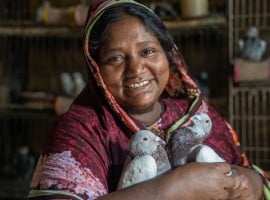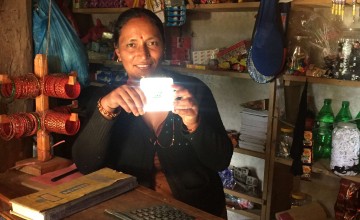
Read our 2024 annual report

Knowledge Hub
Solar technology lights up Nepal (and beyond)

When it comes to innovation, there are few developing technologies with as much positive potential as solar power. But the impact isn’t just environmental: it’s brightening up our humanitarian and development work too.
Nepal in the dark
After the earthquake, navigating the built environment of Nepal was not unlike an assault course. Tendrils of frayed electrical cable dangle over the broken pathways, a spaghetti-like chaos that makes up the ad hoc electrical grid. Weeks after the 7.8-magnitude earthquake shook the country, tremors continued and the electrical supply in cities like Kathmandu was consistently disrupted. In the rural areas that Concern Worldwide had been distributing aid, that supply barely existed at all.
Even before the shocks, the people of Nepal were subject to severe loadshedding (rolling electrical blackouts that can keep parts of the country in the dark for up to 16 hours a day). In remote, rural communities lack of electrical light is often offset by the use of toxic kerosene lamps and dangerous homemade back-up generators. Some nights are lit only by the heavy lightning storms that presage monsoon season.
To further stretch an already-struggling system, the Nepal Electricity Authority reportedly suffered millions of dollars of damage to its infrastructure. The reconstruction project could take months, even years.
Solar power in emergencies
There has been huge need in this earthquake-stricken country, whether durable shelter, basic sanitation, livelihood assistance or psychosocial support. We consider light to be one of the most often overlooked needs. With this in mind, Concern Worldwide made LED solar lights a component of our emergency aid distribution.
Developed by Flexiways Solar Solutions, the Solar Muscle is a compact, robust device with a three year lifespan. After recharging during the day, the device stores up enough energy for around 12 hours of light. While useful as personal light sources, the lights can also connect up, providing more than enough brightness for an entire household. Perhaps most importantly: they come at a low unit cost, meaning to date we have been able to distribute tens of thousands of them around the world – 10,000 of which are now being distributed in Nepal.
This is not the first emergency situation that solar power has helped to drive our humanitarian work. In the wake of the Haiti earthquake, free-standing solar lights were installed in camps, directly reducing rates of gender-based violence in camps. After Typhoon Haiyan struck the Philippines in November 2013, the distribution of solar lights were a popular addition to our aid kits – these little devices were the first source of electrical light on some islands entirely removed from the electrical grid.
Beyond Nepal
It is not just in an emergency context that this technology has enormous potential. Some 1.5 billion people across the world live without a steady source of electricity. In areas where literacy is low, every extra hour of light that children can spend on homework is essential. Where women live with threat of gender-based violence, they can function as an extra beacon of security. And in rural communities where cottage industry is a vital economic lifeline, these lights allow the flexibility of working at night.
In Western countries, solar power is enjoying its moment in the sun. Last year, the solar business grew by 30 percent in the US as more and more homes go off-grid. In California, a new plan has been announced to subsidise solar panels for lower-income households, meaning that its economic potential is spreading beyond large businesses and middle class families.

Similarly, solar energy is becoming increasingly useful in larger-scale development projects in more marginal contexts. In Tanzania, Concern is implementing solar-powered water systems to deliver unprecedented quantities of safe drinking water. In the photograph above, Gloria Kafuria, one of our water and sanitation engineers, has designed a solar water system that delivers safe drinking water to as many as 3,000 people a day.
In countries where we support conservation agriculture programmes, we use solar-charged digital data gathering devices to conduct surveys in area with no electricity, allowing us to rapidly respond with improvements to farming techniques. And in Liberia, solar panels are helping to provide power to hospitals – a vital component of our response to the Ebola crisis.
But for now, the small-scale, direct human impact that solar lights offer make them a nifty addition to the arsenal of relief technology. A month after distributing these lights we visited Jhule, a village in Nepal’s severely damaged Dolhaka district. As soon as our translator mentions the lights, a group of women jostle about with testimonies: Rita Kaski is delighted she no longer has to dine in darkness; Bahadur Karki is able to keep her kitchen lit through power-cuts; and Prabha Basnet, a shopkeeper, has taken to wearing her light like a necklace: “I use it both at home and in my shop,” she tells us.
Solar power’s ecological potential has long been clear, but continuing innovation in harnessing the sun’s energy is energising humanitarian and development projects across the globe. Unlike oil wells, coal mines and gas fields, there is no monopoly on the sun – we can, in fact, all own at least one little piece of its power.
Follow Concern on Instagram
Keep up to date with all of Concern's work by following us on Instagram.


